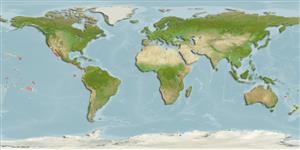Common names from other countries
Environment: milieu / climate zone / depth range / distribution range
Ecologia
; intervalo de profundidade 0 - 30 m (Ref. 96968). Tropical; 30°N - 17°N, 113°W - 106°W
Eastern Central Pacific.
Length at first maturity / Tamanho / Peso / Idade
Maturity: Lm ? range ? - ? cm Max length : 22.0 cm ML macho/indeterminado; (Ref. 96968)
Maximum total length is over 1 meter. It is fished along Baja California, on both sides of the southern Gulf of California and south to Oaxaca. It is fished from March to October (Ref. 96968). This is a benthic species found on soft bottoms, particularly in intertidal and subtidal areas (Ref. 83938). Opportunistic predator, foraging at night on a wide variety of prey (Ref. 108489).
Life cycle and mating behavior
Maturidade | Reprodução | Desova | Ovos | Fecundidade | Larvas
Members of the class Cephalopoda are gonochoric. Male and female adults usually die shortly after spawning and brooding, respectively. Mating behavior: Males perform various displays to attract potential females for copulation. During copulation, male grasp the female and inserts the hectocotylus into the female's mantle cavity where fertilization usually occurs. Life cycle: Embryos hatch into planktonic stage and live for some time before they grow larger and take up a benthic existence as adults.
Hochberg, F.G. and Y.E. Camacho-García. 2009. (Ref. 83938)
Status na Lista Vermelha da IUCN (Ref. 130435)
Status no CITES (Ref. 108899)
Not Evaluated
Not Evaluated
Uso pelos humanos
Pescarias: espécies comerciais
| FishSource |
Ferramentas
Mais informação
Idade/Tamanho
Crescimento
Comprimento-peso
Comprimento-comprimento
Morfologia
Larvas
Abundância
Fontes da internet
Estimates based on models
Preferred temperature
(Ref.
115969): 22.3 - 28.7, mean 25.1 (based on 142 cells).
